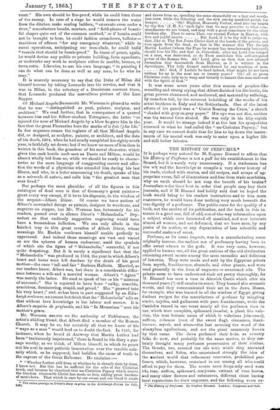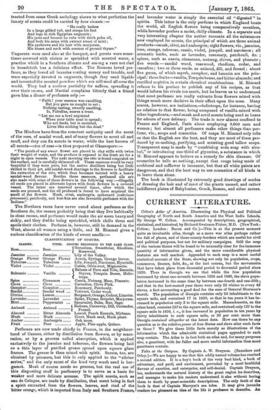THE HISTORY OF PERFUMES.*
IT is perhaps very natural for M. Eugene Rimmel to affirm that his History of Peifurnes is not a puff for his establishment in the Strand, but it is surely very unnecessary. If a tradesman has the wit and the knowledge to compile a very clever history of his trade, choked with stories, and old recipes, and scraps of ap- propriate verse, full of illustrations and free from trade acerbities, why on earth should he not reap the benefit of his brains? Journalists write their best in order that people may buy their journals, and if M. Rimmel had boldly said that lie hoped the book would bring to his readers instruction and to him more customers, be would have done nothing very much beneath the true dignity of a perfumer. The public cares for the quality of a book, not the motive of its publication, and the book in this in- stance is a good one, full of odd, out-of-the-way information upon a subject which once interested all mankind, and now interests almost all women, and not deformed, that we have seen, by any praise of its author, or any depreciation of less scientific and successful makers of scent.
Perfume, as its name imports, was in a manufacturing sense originally incense, the earliest use of perfumery having been to offer sweet odours to the gods. It was very soon, however, applied to human use, all the great nations of the old civilization esteeming sweet scents among the most recondite and delicious of luxuries. They were made and sold by the Egyptian priests from myrrh, frankincense, almonds, and other plants, and were used generally in the form of unguents or sweetened oils. The priests seem to have understood their art pretty thoroughly, for M. Rimmel has seen a vase in Alnwick Castle which after six thousand years (9) still retains its scent. They burned also aromatic woods, and they communicated their art to the Jews, Moses, for example, who was learned in all the wisdom of Egypt, giving distinct recipes for the manufacture of perfume by mingling stacte, onycha, and galbanum with pure frankincense, while the Canticles record in one verse nearly all the perfumes then in use, which were camphire, spikenard (sumbul, a plant like vale- rian, the true botanic name of which is valeriana jatainansi), saffron, calamus (root of the sweet flag), cinnamon, frank- incense, myrrh, and aloes—the last meaning the wood of the aloexyluw agallochum, and not the plant commonly known by that name. The Jews perfumed their beds, as country folks do now, and probably for the same motive, as they cer- tainly thought many perfumes preservative of their clothes. The Greeks, too, scented the oils with which' they anointed themselves, and Solon, who entertained strongly the idea of the ancient world that refinement enervates, prohibited per- fumes, which, however, remained in use among all who could afford to pay for them. The scents most frequently used were iris, rose, saffron, spikenard, marjoram, extract of vine leaves, and many other flowers and substances, different cities having local reputations for their unguents, and the following verse ex- • 2714 History of Perfumes. By Eugtine Bin:1nel London: Chapman and Hall. tracted from some Greek anthology shows to what perfection the luxury of scents could be carried by bons vivants "He really bathes
In a large gilded tub, and steeps his feet And legs in rich Egyptian unguents ; His jaws and breasts he rubs with thick palm oil, And both his arms with extract sweet of mint; His eyebrows and his hair with marjoram, His knees and neck with essence of ground thyme."
Unguents were used also at the banquet, and guests were some- times crowned with violets or sprinkled with scented water, a practice which in a Southern climate and among a race not clad in broadcloth has a delicious effect. The Romans loved per- fume, as they loved all luxuries costing money and trouble, and were especially devoted to unguents, though they used liquids and invented the scented powders which are still used all over the world. They had a curious partiality for saffron, spreading it over their rooms, and Martial complains bitterly that a friend gave him a dinner of perfumes only :—
" Faith ! your essence was excelling,
But you gave us naught to eat ; Nothing tasting, sweetly smelling, Is, Fabullus, scarce a treat. " Let me see a fowl unjointed When your table next is spread ; Who not feeds, but is anointed, Lives like nothing but the dead."
The Hindoos have from the remotest antiquity used the scent of the rose, of sandal wood, and of many flowers to scent oil and snuff, and they can fix scents in water, while the best known of all scents—otto of rose—is thus prepared at Ghazeepore:—
" The petals of any sweet flower are placed in clay stills with twice their weight of water, and the produce is exposed to the fresh air for a night in open vessels. The next morning the otto is found congealed on the surface, and is carefully skimmed off. These essences would be very beautiful if they were pure, but the native distillers being but little skilled in their art, add sandal-wood shavings to the flowers to facilitate the extraction of the Otto, which thus becomes tainted with a heavy sandal-wood flavour. Besides these essences, perfumed oils are also made with some of these flowers in the following way :—Gingelly oil seeds are placed in alternate layers with fresh flowers in a covered vessel. The latter are renewed several times, after which the seeds are pressed, and the oil produced is found to have acquired the smell of the flowers. Musk, civet, ambergris, spikenard (valerian jatamansi), patchonly, and kua-kus are also favourite perfumes with the Indians."
The Northern races have never cared about perfumes as the Southern do, the reason probably being that they live habitually in close rooms, and perfumes would make the air seem heavy and sickly, and they dislike being sprinkled, which chills them and spoils their clothes. Perfume is, however, still in demand in the West, almost all women using a little, and M. Rimmel gives a curious classification of the kinds of sweet smells:—
CLASSIFICATION OF ODOURS.
TYPES. ODOURS BELONGLNG TO THE SAME CLASS.
Rose fGeranium, Sweetbriar, Rhodium,
j Rosewood.
Jasmine Lily of the Valley. Orange Flower Acacia, Syringe, Orange leaves. Tuberose Lily, Jonquil, Narcissus, Hyacinth. Violet Cassie, Orris-root, Mignonette. Vanilla )Balsam of Peru and Tolu, Benzoin, Styrax, Tonquin Beans, Helio- trope.
Cinnamon Cassia, Nutmeg, Mace, Pimento. Clove Carnation, Clove Pink. Camphor Rosemary, Patchouly. Sandal wood Vetivert, Cedar wood.
Lemon Bergamot, Orange, Cedrat, Limette.
Lavender Spike, Thyme, Serpolet, Marjoram. Peppermint Spearmint, Balm, Rue, Sage.
Aniseed S Badiane, Carraway, Dill, Coriander, t Fennel.
Bitter Almonds Laurel, Peach Kernels, Mirbane.
Musk Civet, Musk seed, Musk plant. Ambergris Oak moss.
Pear Apple, Pine-apple, Quince.
now made chiefly in France, in the neighbour- hood of Cannes, either by distillation from flowers, or by mace- ration, or by a process called absorption, which is applied exclusively to the jasmine and tuberose, the flowers being laid on a thin layer of purified grease spread upon square glass frames. The grease is then mixed with spirit. Scents, too, are obtained by pressure, but this is only applied to the " citrine series," and the only scent of the kind very much used is ber- gamot. Musk of course needs no process, but the real use of this disgusting stuff in perfumery is to serve as a basis for weaker and more delicate aromas. The spirit scents, such as eau de Cologne, are made by distillation, that scent being in fact a spirit extracted from the flowers, leaves, and rind of the bitter orange, which is imported from Italy and Southern Frances
CLASSES.
Rose Jasmine
Orange Flower Tuberose Violet Balsamic Clore Camphor Sandal Citrine Lavender Mint Aniseed Almond Musk Amber
Fruit Perfumes are
and lavender water is simply the essential oil " digested " in spirits. This latter is the only perfume in which England beats the world, all. English flowers being comparatively scentless, while lavender prefers a moist, chilly climate. In a separate and very interesting chapter the author recounts all the substances now employed for scents, the principal of which are three animal products—musk, civet, and ambergris; eight flowers, viz., jasmine, rose, orange, tuberose, cassie, violet, jonquil, and narcissus ; all aromatic herbs, such as lavender, rosemary, patchouli, &c. ; spices, such as cassia, cinnamon, nutmeg, cloves, and pimento ; five woods — sandal wood, rosewood, rhodium, cedar, and sassafras; two or three seeds, as aniseed, dill, and fennel ; about five gums, of which myrrh, camphor, and benzoin are the prin- cipal; three fruits—vanilla, Tonquin beans, and bitter almonds; and rectified naphtha in certain chemical combinations. M. Rimed refuses in his preface to publish any of his recipes, as that would inform his rivals too much, but he leaves us to understand that most perfumes are really extracts from flowers mixed with things much more decisive in their effect upon the nose. Many scents, however, are imitations,—heliotrope, for instance, having no relation to that flower, being composed of vanilla mixed with other ingredients,—and musk and acrid scents being used as bases for odours of rare delicacy. The trade is now almost confined to France and England, Paris alone employing 3,000 men and women ; but almost all perfumers make other things than per- fume, viz., soaps and cosmetics. Of soaps M. Rimmel only tells us that the English are the best, and they are most of them pro- duced by re-melting, purifying, and scenting good tallow soaps. Transparent soap is made by " combining soda soap with alco- hol," or introducing one-third of glycerine, a substance in which M. Rimed appears to believe as a remedy for skin diseases. Of cosmetics he tells us nothing, except that rouge being made of cochineal and safflower is innocent, but that all white paints are dangerous, and that the best way to use cosmetics of all kinds is to leave them alone.
The book is illustrated by extremely good drawings of modes of dressing the hair and of most of the plants named, and rather indifferent plates of Babylonian, Greek, Roman, and other scenes_





































 Previous page
Previous page